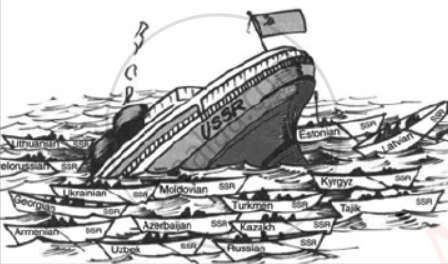Advertisements
Advertisements
प्रश्न
Arrange the following in chronological order:
- Soviet invasion of Afghanistan
- Fall of the Berlin Wall
- Disintegration of Soviet Union
- Russian Revolution
उत्तर
- (d) Russian Revolution (1917)
- (a) Soviet invasion of Afghanistan (1979)
- (b) Fall of the Berlin Wall (Nov 1989)
- (c) Disintegration of Soviet Union
APPEARS IN
संबंधित प्रश्न
What is the full form of “SAARC”?
Which one of the following was NOT given primacy by the makers of the soviet system?
(a) Abolition of private property
(b) Society based on the principle of equality
(c) No opposition party to be allowed
(d) No state control over economy
Which among the following statements that describe the nature of the Soviet economy is wrong?
Fill in the blank :
The Soviet political system was based on ___________________ ideology.
Fill in the blank:
____________________ party dominated the Soviet Union’s political system.
Mention any three features that distinguish the Soviet economy from that of a capitalist country like the US.
The USSR came into being after the socialist revolution in Russia in the year ____________.
The successor country to the Soviet Union is ____________.
The warsaw pact was ____________.
In which year Warsaw Pact was disbanded?
How many Union Republics were there in U.S.S.R.?
Which among the following statements about Soviet System is not true?
Study the following diagram and answer accordingly.

What led to the dissolution of the Soviet Union?
Read the following passage and answer accordingly.
Economist Jeffrey Sachs is widely associated with shock therapy. He developed a plan of shock therapy for post-communist Poland in 1990, for post-communist Russia in 1992, and several other countries, including Bolivia and Chile.
Bolivia, in particular, in 1985, had success as a result of shock therapy in ending a period of hyperinflation.
Poland also initially seemed to benefit from shock therapy as inflation was controlled, but it saw a sharp rise in unemployment that peaked at 16.9%.
Sachs did not like the term shock therapy, which he said was coined by the media and made the reform process sound more painful than it was.
In Russia, neo-liberal shock therapy did not produce favourable outcomes. Shock therapy was applied swiftly and in large scale, as opposed to how it was applied to other nations.
Almost all of Russia’s industries were undervalued and sold to private individuals and companies, with most acquired by a few Russian oligarchs.
With limited government intervention, most industries disappeared. The Russian currency declined, causing high inflation and the erosion of most citizens’ savings. Unemployment increased drastically, and government subsidies were removed, further pushing Russian families into poverty.
Who developed the plan of the Shock therapy for the post-communist Poland?
Who was the founder head of the USSR during the most difficult period following the revolution (1917-1924)?
What was the military alliance started by the USSR?
During the Cold War era, India and the USSR enjoyed a special relationship which led critics to say that India was part of the Soviet camp. It was which of the following type of relationship?
Which one of the following statements was not a feature of the Soviet System?
Which of the following statements was not a feature of the Soviet System?
”The Soviet Union became a great power after the Second World War. However, in no time, the Soviet system became bureaucratic and authoritarian making life difficult for its citizens.” Do you agree with the given statement? Give arguments to prove your answer.
